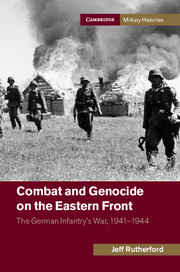Book contents
- Frontmatter
- Table of contents
- List of illustrations
- List of figures
- List of maps
- List of tables
- Acknowledgments
- Introduction
- 1 The Wehrmacht and German society
- 2 Preparations for war
- 3 “Attack with a ruthless offensive spirit and … a firestorm of destruction”
- 4 “Will the continuation of this attackbe worth it?”
- 5 “It is only a question of where, not if, civilians will starve”
- 6 The failure of Operation Barbarossa
- 7 The Soviet winter offensive, 1942
- 8 “The population … shouted out to the interpreter that one would rather be shot instead of being left to starve”
- 9 “From one mess to another”
- 10 “We need to fight to the end, so oder so”
- 11 A more rational occupation?
- 12 “As miserable representatives of themiserable twentieth century, we burnedall of the villages”
- Conclusion
- Bibliography
- Index
- References
4 - “Will the continuation of this attackbe worth it?”
The drive on Leningrad
Published online by Cambridge University Press: 05 July 2014
- Frontmatter
- Table of contents
- List of illustrations
- List of figures
- List of maps
- List of tables
- Acknowledgments
- Introduction
- 1 The Wehrmacht and German society
- 2 Preparations for war
- 3 “Attack with a ruthless offensive spirit and … a firestorm of destruction”
- 4 “Will the continuation of this attackbe worth it?”
- 5 “It is only a question of where, not if, civilians will starve”
- 6 The failure of Operation Barbarossa
- 7 The Soviet winter offensive, 1942
- 8 “The population … shouted out to the interpreter that one would rather be shot instead of being left to starve”
- 9 “From one mess to another”
- 10 “We need to fight to the end, so oder so”
- 11 A more rational occupation?
- 12 “As miserable representatives of themiserable twentieth century, we burnedall of the villages”
- Conclusion
- Bibliography
- Index
- References
Summary
As Ernst Klink has remarked, the “basic problem confronting the Wehrmacht in the East [was] providing the necessary fighting forces in an expanding theater of operations from an unchanging and limited number of available soldiers.” While this proved to be an increasingly insurmountable problem for Army Groups Center and South due to their deployment in much more expansive areas, Leeb’s army group also found that the factors of time and strength began to work against a successful campaign in the late summer and early fall of 1941. He noted that his front had grown from 200 kilometers at the beginning of the invasion to one that stretched over 650 kilometers by mid-July, while the strength of the army group had decreased with the loss of two divisions. Leeb believed that he required thirty-five divisions to successfully complete his various missions, but he had only twenty-six at his disposal. The transfer of these divisions to Army Group Center highlighted the increasing confusion within the German command over the operation’s ultimate goals. The simmering conflict between Hitler and the OKH that existed from the very beginning of the campaign now began to boil over: was the focus of the operation to be Moscow, as favored by Halder, or the advance on the wings, as advocated by Hitler?
Leeb, as commander of the formation charged with capturing the cradle of Bolshevism, certainly wanted to pin this honor to his mantle. The constant hemorrhaging of troops to Army Group Center, however, decreased the likelihood of such a triumph. Compounding this problem, the terrain lying across the most direct route to Leningrad was a swampy morass, “thoroughly unsuitable as tank country.” As the situation developed up through mid-July, Leeb became increasingly convinced that “large [armor] raids need to be avoided” and he forced Panzer Group 4 to wait for the advancing infantry to close up and strengthen its forces for what he believed would be a much more traditional battle.
- Type
- Chapter
- Information
- Combat and Genocide on the Eastern FrontThe German Infantry's War, 1941–1944, pp. 115 - 150Publisher: Cambridge University PressPrint publication year: 2014



